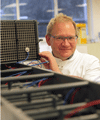September
Fuelling the future

Experts have been explaining how they have harnessed the energy locked up in sewage to power our waste water treatment at the British Science Festival.
Sewage plants have the ability to produce the power to run themselves and also clean energy for the future, Newcastle University researchers have found.
Experts from Northumbrian Water Ltd and Newcastle University reveal how they have carried out the first trial of a hydrogen Microbial Electrolysis Cell (MEC) on raw sewage at a waste water treatment works on Tyneside.
Funded by the Engineering and Physical Sciences Research Council (EPSRC), the team are now preparing to install the next generation of MEC at a waste water treatment works in Sedgefield, County Durham.
Harnessing the power of the billions of naturally-occurring microbes in our sewage, the team have shown that not only can wastewater treatment plants be completely self-powered and the treatment process improved - they can also be used to produce significant quantities of valuable hydrogen gas. This could be collected and used, for example, to power electric vehicles, or the electrons and hydrogen could be combined to make higher value organic chemicals.
This new system, led by Tom Curtis, Professor of Biological Engineering, Keith Scott, Professor of Electrochemical Engineering and Dr Elizabeth Heidrich, all of Newcastle University, takes this to the next level. Using raw, untreated waste water at normal temperatures, the entire process is fuelled using the energy from bugs.
Professor Curtis explains: “We spend a lot of electricity treating sewage and it’s totally unnecessary.
“Waste water contains two to three times more energy than we use to treat it so if we can harness that energy we can not only close the loop on sewage treatment to create a totally self-treating system, we will also have spare energy to use elsewhere.
“What’s really clever about this system is that it works on raw sewage at ambient temperature. Most anaerobic digesters require a high-energy, concentrated food source and heat to work properly which means the water has to be removed first and this is an energy-expensive process.
“What we have developed is a system that feeds on the waste as it arrives at the plant – the whole lot goes in and the microbes do all the hard work.”
Around 2% of all electricity used in the UK is used to treat wastewater while the energy stored in UK wastewater is equivalent to five billion barrels of oil a year.
Northumbrian Water is already leading the water industry with its award-winning £70 million ‘power from poo’ advanced anaerobic digestion (AAD) plants at Howdon on Tyneside and at Bran Sands on Teesside.
In these two locations, all the sludge remaining after the wastewater from 2.6 million customers in the North East has been treated and is already producing gas which is being turned into electricity.
Maxine Mayhew, Commercial Director for Northumbrian Water, said: “As the industry leader for generating sustainable power from poo it’s a natural progression for us to look to science to see what more can be achieved in the future.
“Currently we are harvesting the methane released by bacteria as they digest the sludge which is then used in gas engines to create electricity.
“Now, in another innovative move to maximise the energy production, we are working to upgrade and purify the biogas so it can be directly injected into the gas grid.
“As industry pioneers of generating power from wastewater we now look to our work with Newcastle University to take this energy production to another level and develop production of hydrogen - the clean fuel of the future.”
How the process works:
MECs are the next generation of microbial fuel cells. In the Newcastle design, each MEC is composed of a number of removable “cassettes” – similar to the frames inside an artificial beehive.
Each cassette is made up of carbon felt trapped between metal meshing and connected to a positive and negative electricity supply.
As the raw sewage is pumped through the cell, the microbes growing on the carbon felting strip the electrons off the ‘food’ or sewage and transfer these to the anode, producing electricity. Meanwhile the hydrogen ions that are left migrate to the cathode where they are reunited with the electrons which have been topped up with just enough energy to allow them to turn the hydrogen ions into hydrogen gas. The energy required to “top up” the electrons is less than the energy released. So the system is potentially energy positive.
Currently this hydrogen is released, but Professor Curtis says the hydrogen could be collected as a clean and valuable fuel or, better still, the electrons and hydrogen could be combined to make higher value organic chemicals.
So will we be powering Britain with sewage in years to come?
“Unlikely,” says Professor Curtis, “but it’s a start. I think if there’s one thing we all realise it’s that there’s no magic bullet – no single source of sustainable energy that is going to save the world.
“But if every University in the country could save 2% of the nations electricity bill we would be a long way down the road to sustainability.
“Most importantly, wasting energy in wastewater treatment is increasingly a global problem. As the BRICS urbanise and adopt our energy intensive treatment technologies in a world of rising energy costs we are all going to be in the same boat.”
published on: 12 September 2013
